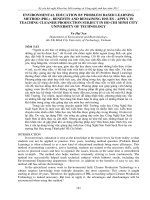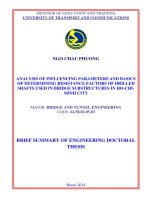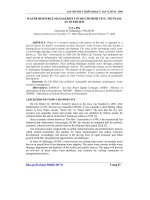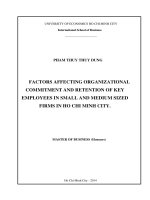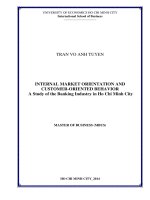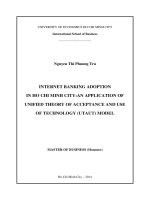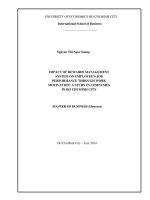Applying logistics and supply chain management model to wholesale system in ho chi minh city
Bạn đang xem bản rút gọn của tài liệu. Xem và tải ngay bản đầy đủ của tài liệu tại đây (519.4 KB, 106 trang )
HO CHI MINH CITY OPEN UNIVERSITY
UNIVERSITEÙ LIBRE DE BRUXELLES
SOLVAY BUSINESS SCHOOL
MASTER IN MANAGEMENT PROGRAM (MMVCFB 6)
PHAM NHU HIEN
APPLYING LOGISTICS AND SUPPLY CHAIN
MANAGEMENT MODEL TO WHOLESALE SYSTEM
IN HO CHI MINH CITY
Major: Management
Master in Management Thesis
Advisor: Dr. Ta Thi My Linh
Ho Chi Minh City
2007
UNDERTAKING STATEMENT:
I hereby undertake that this is my own research. All data and results
stated in the thesis are completely true.
Pham Nhu Hien
ACKNOWLEGEMENT
I would like to express my deep gratitude and great appreciation to Dr. Ta Thi My
Linh, my thesis advisor for her valuable guidance, encouragement, support, and
sharing knowledge throughout my thesis.
I would also like to express my deep gratitude to Professors of Universiteù Libre de
Bruxelles, Solvay Business School and Ho Chi Minh City Open University for
providing knowledge and giving valuable experience during my study.
I would also like to take this opportunity to give my special thanks to my family,
colleagues and friends for their continuing support.
PREFACE
1. Rational of the thesis
Logistics and SCM as a whole, is a fairly new management tool and one, which
more and more companies are finding useful in giving them a competitive edge in
business. In today economy, optimization is the key word in any business success
story and Logistics and SCM is one of the major applications in the business world
which can address many of the challenges faced by an organization.
As the economy in Vietnam changes and as competition becomes more global, it is
no longer company vs. company operating in a domestic business environment but
the Supply Chain vs. Supply Chain. The goal of any progressive company is to
combine the many Logistics pipelines from manufacturer to final consumer, which
include value-added processes that deliver innovative, high-quality, low-cost
products on time with greater responsiveness that ever before and wholesale system
is not exceptionable.
Wholesale system plays a key function in smoothly moving the flow of goods, cash
and information within the whole distribution system. This realization has led
wholesale companies to look beyond their boundaries to evaluate how the resources
of their suppliers and customers can be utilized to create the exceptional value
demanded by customers. In theory, Supply Chain integration allows the
organization to focus on doing exceptionally well a few things for which it has
unique skills and advantages. Non-core activities are then shifted to other channel
members that possess superior capabilities in those areas. When appropriate, close
relationship are formed to ensure outstanding performance levels. These allied
teams of wholesale companies then form an integrated Supply Chain, which is able
to compete against other Supply Chain.
However, in reality, approaches to SCM vary substantially from organization to
organization and even from manger to manger within the same company. Indeed,
few companies have adopted a formal definition of SCM. Even fewer have
carefully mapped out their Supply Chain so that they know who their suppliers’
supplier or customers’ customers really are and are able to find a way to apply
successfully the Logistics and SCM to their organization.
Therefore, the author chose the thesis: “Applying Logistics and SCM model to
wholesale system in HCMC”
2. Objective of the research
-
To make clear issues belong to literature review of Logistics, Supply Chain,
SCM, wholesale.
-
To adapt theory of Logistics and SCM to wholesale system in HCMC to
improve the management capacity of wholesale companies in the movement
of goods, the movement of cash and the movement of information.
3. Scope and Limitation of the study
-
Researching about the current applying Logistics and SCM situation of
wholesale trading and distributing companies in consumer goods field in
HCMC.
-
Researching and giving recommendation to improve the operation activities
of wholesale system and suggest a suitable Logistics and SCM model.
4. Research Methodology
The research is carried out basing on three main steps:
First of all, secondary data is gathered and processed to provide a literature review
of current theory of Logistics, SCM, Wholesale system.
The next step is to investigate the current situations of wholesale system in HCMC
by collecting reports from Government’s agency and through a qualitative research
and through a questionnaire survey to analysis the current appliance situation of
Logistics and SCM to wholesale companies..
The third step is to give out some important recommendations to improve current
operational activities of wholesale system and suggest a suitable Logistics and SCM
model
5. Structure of the thesis
Chapter One: Literature review of Logistics, SCM and wholesale system
Chapter Two: The reality overview of the appliance of Logistics and SCM to
wholesale system in HCMC
Chapter Three: Orientation for the appliance of Logistics and SCM to the wholesale
system in HCMC
1
TABLE OF CONTENT
Title page
Undertaking Statement
Acknowledgement
Preface
Table of content
List of abbreviation
List of figure
List of table
Chapter 1: Literature review of Logistics, Supply Chain Management, Wholesale system . 7
1.1 General literature review of Logistics and Supply Chain Management ..........7
1.1.1 Logistics – a part of supply chain .................................................................7
1.1.1.1 Definition of Logistics ...........................................................................7
1.1.1.2 Classification of Logistics......................................................................8
1.1.1.3 Logistics Management...........................................................................9
1.1.2 Definition of SCM .......................................................................................11
1.1.2.1 Definition of supply chain and SCM...................................................11
1.1.2.2 General operation of SCM ..................................................................13
1.2 Function of Logistics and SCM .........................................................................15
1.2.1 Strategic Function........................................................................................16
1.2.2 Tactical function ...........................................................................................16
1.2.3 Operational function.....................................................................................17
1.3 Objectives of Logistics and SCM ....................................................................18
1.3.1 Reducing transportation and Logistics cots to minimum level .................18
1.3.2 Reducing the investing capital in transportation system............................18
1.3.3 Improving the customer service ..................................................................18
1.4 Literature of wholesale distribution system .....................................................19
1.4.1 Definition of Wholesale ..............................................................................19
1.4.1.1 Definition..............................................................................................19
1.4.1.2 Type of wholesale................................................................................20
1.4.1.3 Wholesale Management ......................................................................21
1.4.2 Organization Structure and Operational Process of wholesale company 23
1.4.2.1 Some popular organization structure .................................................23
1.4.2.2. Operational Process ............................................................................25
2
1.4.3 Function of wholesale in economy ..............................................................27
1.4.3.1 Being a key chain in the whole distribution system of the economy 27
1.4.3.2 Increasing value added services which help to increase revenue ....28
1.4.3.3 Ensuring the supply source for the market .........................................29
1.4.4 The importance of the appliance of Logistics and SCM model to
wholesale system...................................................................................................29
1.4.4.1 Ensuring the non-stop flow of commodity.........................................30
1.4.4.2 Ensuring the movement of information flow......................................31
1.4.4.3 Ensuring the movement of cash flow..................................................31
Chapter Two: The reality overview of the appliance of Logistics and SCM to wholesale
system in HCMC
................................................................................ 33
2.1 Overview of wholesale system in HCMC ........................................................33
2.1.1 Business result of wholesale system ..........................................................33
2.1.2 Quantity and current situation of wholesale system in HCMC..................36
2.2 Analysis of the current appliance of Logistics and SCM model of wholesale
system in HCMC .......................................................................................................39
2.2.1 Micro Analysis.............................................................................................39
2.2.1.1 Major Competence..............................................................................41
2.2.1.2 Planning ...............................................................................................43
2.2.1.3 Implementation ...................................................................................45
2.2.1.4 Monitoring and Adjustment................................................................48
2.2.1 Macro analysis.............................................................................................51
Chapter Three: Orientation and recommendations to apply Logistics and SCM model to
wholesale system in HCMC.
......................................................................................... 55
3.1 The foundation to apply Logistics and SCM model to wholesale system in
HCMC ........................................................................................................................55
3.1.1 Industrial view ..............................................................................................55
3.1.2 Enterprise view.............................................................................................55
3.2 Orientation for the appliance of Logistics and SCM to the wholesale system
in HCMC ....................................................................................................................57
3.3 Recommendations to build up a suitable Logistics and SCM model ..............58
3.3.1Recommendations to improve the current situation of wholesale system 58
3.3.1.1 Recommendations for enterprise ........................................................59
3.3.1.2 Recommendations for State.................................................................61
3.3.2 Recommendations to build up a suitable Logistics and SCM model .......62
3.3.2.1 Model recommendation: create a vertical alliance – Integrated
Logistics and SCM. ............................................................................................62
3
3.3.2.2 Content of the model............................................................................63
3.3.2.3 Barriers to the outsourcing model .......................................................66
3.3.2.4 Benefits of the Model ..........................................................................68
3.3.2.5 Some remarkable for an successful outsourcing ................................69
Conclusion…………………………………………………………………………………………………………………………………………… 73
Recommendation for further studies………………………………………………………………………………………….75
Bibliography
Appendix
4
LIST OF ABBREVIATION
3PL
Third Party Logistics
ADB
Asian Development Bank
CLM
Council of Logistic Management
EDI
Electronic Date Interchange
ERP
Enterprise Resource Planning
GDP
Gross Domestic Product
GSO
General Statistics Office
HCMC
Ho Chi Minh City
IMF
International Monetary Fund
IT
Information Technology
JIT
Just-In-Time
KPI
Key Performance Indicator
MPI
Ministry of Planning and Investment
P.O
Purchasing Order
SCM
Supply Chain Management
VCCI
Vietnam Chamber of Commerce and Industry
WB
World Bank
WMI
Warehouse Management Interchange
WMS
Warehouse Management System
WTO
World Trade Organization
5
LIST OF FIGURE
Figure 1: Logistics process
........................................................................................... 8
Figure 2: Business Logistics activities...................................................................................... 9
Figure 3: Logistics Management Flow ................................................................................... 10
Figure 4: An example of supply chain.................................................................................... 11
Figure 5: Supply Chain Management Integration.................................................................. 12
Figure 6 : Hierarchy of Supply Chain Function ..................................................................... 15
Figure 7: Wholesaler’s position in the distribution channel.................................................. 19
Figure 8: An example of functional structure ........................................................................ 23
Figure 9: An example of Multi-divisional structure .............................................................. 24
Figure 10: An example of Matrix structure............................................................................ 25
Figure 11: Distribution channel without wholesaler .............................................................. 27
Figure 12: Distribution channel with wholesaler ................................................................... 28
Figure 13: The importance of Logistics and SCM to wholesale ........................................... 30
Figure14: Total sales of goods and services of HCM city from 2000 to 2006. ...................36
Figure 15: Appliance of Logistics and SCM situation ........................................................... 40
Figure 16: Overall statistic of 98 companies for 04 parts of the questionnaire.................... 41
Figure 17: Major Competence Score Summary..................................................................... 42
Figure 18: Internal policy score summary.............................................................................. 43
Figure 19: Percentage of companies doing planning............................................................. 44
Figure 20: Planning strategy’s component score summary ................................................... 45
Figure 21: Implementation ability as per percentage............................................................ 46
Figure 22: Summary score of outsourcing field ..................................................................... 47
Figure23: Transportation problems met by wholesale distribution companies in HCMC... 48
Figure 24: Monitoring and Adjustment ability as per percentage ........................................ 49
Figure 25: Summary score of popular monitoring tools ........................................................ 50
Figure 26: Integrated Logistics and SCM Model................................................................... 63
Figure 27: Logistics and SCM activities which 3PLs can offer to customer ........................ 64
6
LIST OF TABLE
Table 1: The contribution of Trade to GDP of HCM city in 2006. ....................................... 34
Table 2: Total sales of goods and services in 2006 of HCM city by economic sectors. .... 34
Table 3: Total retail sales of goods and services of HCM city by economic activity.......... 35
Table 4: Assess the effectiveness of Vietnam transport policies.......................................... 52
Table 5: Percentage of transport mode used for moving freight .......................................... 53
7
Chapter 1: Literature review of Logistics, Supply Chain Management,
Wholesale system
1.1 General literature review of Logistics and Supply Chain Management
1.1.1 Logistics – a part of supply chain
1.1.1.1 Definition of Logistics
Logistics is the art and science of strategically managing and controlling the flow of
goods, energy, information and other resources like products, services, and people
from the source of production to the marketplace. The Oxford English dictionary
defines Logistics as: “The branch of military science having to do with procuring,
maintaining and transporting material, personnel and facilities.”
This definition puts logistics in a military context. To the extent that business
objective and activities differ from those of the military, this definition does not
capture the essence of business logistics.
Business Logistics is a process which interfaces and interacts with the entire
company and with external companies, vendors, customers, carriers and more. It is
not shipping and receiving, nor is it traffic or warehousing. It is more. Business
Logistics is responsible for the movement of products from vendors right through to
the delivery at your customer's door, including moves through manufacturing
facilities, warehouses, third-parties. In general, Logistics can be defined as having
the right item in the right quantity at the right time for the right price with the least
costly amount.
8
Figure 1: Logistics process
1.1.1.2 Classification of Logistics
• Basing on process:
Inbound Logistics is activities ensuring input resources supply (materials,
information, capital) ultimately both in location, time and cost for production stage.
Outbound Logistics is activities ensuring to hand on the products to end users
ultimately both in location, time and cost in order to maximize the profit.
Reverse Logistics is process to collect wastes, substandard products, by-products
incurring from production, distribution and consuming process which may cause
harm to environment back to recycle or give treatment
• Basing on industry:
Military Logistics
In military logistics, experts manage how and when to move resources to the places
they are needed. In military science, maintaining one’s supply lines while disrupting
those of the enemy is a crucial element of military strategy, since an armed force
without food, fuel and ammunition is defenseless.
9
Business Logistics
In the business, Logistics may have either internal focus, or external focus,
covering the flow and storage of materials from point of origin to points of
consumption.
The main activities include Inventory Management, Purchasing,
Transport, Warehousing, and the organizing and planning of these activities.
Figure 2: Business Logistics activities
Production Logistics - The purpose of production logistics is to ensure that each
machine and workstation is being fed with the right product in the right quantity and
quality at the right point in time. The issue is not the transportation itself, but to
streamline and control the flow through the value adding processes and to eliminate
non-value adding ones. Production logistics provide the means to achieve customer
response and capital efficiency.
1.1.1.3 Logistics Management
According to the CLM, a professional organization of logistics managers, educators,
and practitioners formed in 1962 for the purpose of continuing education and
fostering the interchange of ideas, Logistics Management is the process of planning,
10
implementing, and controlling the efficient, cost-effective flow and storage of raw
materials, in-process inventory, finished goods and related information from point
of origin to point of consumption for the purpose of conforming to customer
requirements.
Figure 3: Logistics Management Flow
These are the boundaries and relationships of Logistics Management adopted by the
CLM: "Logistics Management activities typically include inbound and outbound
transportation management, fleet management, warehousing, materials handling,
order fulfillment, logistics network design, inventory management of third party
logistics services providers. To varying degrees, the logistics function also includes
sourcing and procurement, production planning and scheduling, packaging and
assembly, and customer service. It is involved in all levels of planning and
execution -- strategic, operational and tactical. Logistics Management is an
integrating function, which coordinates and optimizes all logistics activities, as well
as integrates logistics activities with other functions including marketing, sales
manufacturing, finance and information technology."
11
1.1.2 Definition of SCM
1.1.2.1 Definition of supply chain and SCM
Various definitions of a supply chain have been offered in the past several as the
concept has gained popularity. The APICS Dictionary describes the supply chain as:
1. the processes form the initial raw materials to the ultimate consumption of
the finished product linking across supplier-user companies; and
2. the functions within and outside a company that enable the value chain to
make products and provide services to the customer
Another source defines supply chain as, the network of entities through which
material flows. Those entities may include suppliers, carriers, manufacturing sites,
distribution centers, retailers, and customers. The Supply Chain Council (1997) uses
the definition: “The Supply Chain – a term increasingly used by logistics
professionals – encompasses every effort involved in producing and delivering a
final product, from the supplier’s supplier to the customer’s customer. Four basic
processes – plan, source, make, deliver – broadly define these efforts which include
managing supply and demand, sourcing raw materials and parts, manufacturing and
assembly, warehousing and inventory tracking, order entry and order management,
distribution across all channels, and delivery to the customer.”
Figure 4: An example of supply chain
12
In addition to defining the supply chain, several authors have further defined the
concept of SCM. As defined by Ellram and Cooper (1993), SCM is “an integrating
philosophy to manage the total flow of a distribution channel from supplier to
ultimate customer”. Monczka and Morgan (1997) state that “integrated SCM is
about going from the external customer and then managing all the processes that
are needed to provide the customer with value in a horizontal way”.
SCM coordinates and integrates all of these activities into a seamless process. It
links all of the partners in the chain including departments within an organization
and the external partners including suppliers, carriers, third party companies, and
information systems providers. Managers in companies across the supply chain take
an interest in the success of other companies. They work together to make the
whole supply chain competitive. They use technology to gather information on
market demands and exchange information between organizations. A key point in
SCM is that the entire process must be viewed as one system. Any inefficiencies
incurred across the supply chain (suppliers, manufacturing plants, warehouses,
customers, etc.) must be assessed to determine the true capabilities of the process.
Figure 5 describes the total integration required within the supply chain.
Total Information Visibility
Create Demand
Source to Demand
Make to Demand
Figure 5: Supply Chain Management Integration
Deliver to Demand
13
1.1.2.2 General operation process of SCM
Operation process of SCM involves collaborative work between buyers and
suppliers, joint product development, common systems and shared information. It is
suggested key critical SCM process combining these processes stated by Lambert
(2000) such as: Customer service management process; Procurement management;
Product development and Commercialization; Inventory flow management;
Physical Distribution; Performance Measurement.
•
Customer service management process.
Customer service provides the source of customer information. It also provides the
customer with real-time information on promising dates and product availability
through interfaces with the company’s production and distribution operations.
•
Procurement
In firms where operations extend globally, sourcing should be managed on a global
basis. Activities related to obtaining products and materials from outside suppliers.
This requires performing resource planning, supply sourcing, negotiation, order
placement, inbound transportation, storage and handling and quality assurance. Also,
includes the responsibility to coordinate with suppliers in scheduling, supply
continuity, hedging, and research to new sources or programs.
• Product development and commercialization
Here, customers and suppliers must be united into the product development process,
thus to reduce time to market. As product life cycles shorten, the appropriate
14
product must be developed and successfully launched in ever shorter timeschedules to remain competitive. It is required:
1. coordinate with customers relationship management to identify customerarticulated needs;
2. select materials and suppliers in conjunction with procurement, and
3. develop production technology in manufacturing flow to manufacture and
integrate into the best supply chain flow for the product/ market combination.
• Inventory flow management process
Orders are processes operating on a JIT basis in minimum lot sizes. Also, changes in
the manufacturing flow process lead to shorter cycle times, meaning improved
responsiveness and efficiency of demand to customers. Activities related to
planning, scheduling and supporting manufacturing operations, such as work-inprocess storage, handling, transportation, and time phasing of components,
inventory at manufacturing sites and maximum flexibility in the coordination of
geographic and final assemblies postponement of physical distribution operations.
• Physical Distribution
This concerns movement of a finished product/service to customers. In Physical
distribution, the customer is the final destination of a marketing channel, and the
availability of the product/ service is a vital part of each channel participant’s
marketing effort. It is also through the physical distribution process that the time and
space of customer service become an integral part of marketing, thus it links a
marketing channel with its customers (e.g. links manufacturers, wholesalers,
retailers).
15
• Performance Measurement
As logistics competency becomes a more critical factor in creating and maintaining
competitive advantage, logistics measurement becomes increasingly important
because the difference between profitable and unprofitable operations becomes
narrower. According to experts internal measures are generally collected and
analyzed by the firm including: Cost, Customer Service, Productivity measures,
Asset measurement, and Quality.
1.2 Function of Logistics and SCM
SCM is a cross-functional approach to managing the movement of raw materials
into an organization and the movement of finish goods out of the organization
toward the end-consumer. These functions are increasingly being outsourced to
other corporations that can perform the activities better or more cost effectively.
The effect has been to increase the number of companies involved in satisfying
consumer demand, while reducing management control of daily logistics operations.
Figure 6: Hierarchy of Supply Chain Function
16
1.2.1
Strategic Function
• Strategic network optimization, including the number, location, and size of
warehouses, distribution centers and facilities.
• Strategic partnership with suppliers, distributors, and customers, creating
communication
channels
for
critical
information
and
operational
improvements such as cross docking, direct shipping, and third-party logistics.
• Product design coordination, so that new and existing products can be
optimally integrated into the supply chain, load management
• Information technology infrastructure, to support supply chain operations.
• Where to make and what to make or buy decisions
• Align Overall Organizational Strategy with supply strategy
1.2.2 Tactical function
• Sourcing contracts and other purchasing decisions.
• Production decisions, including contracting, locations, scheduling, and
planning process definition.
• Inventory decisions, including quantity, location, and quality of inventory.
• Transportation strategic, including frequency, routes, and contracting.
• Benchmarking of all operations against competitors and implementation of
best practices throughout the enterprise.
• Milestone Payments
17
1.2.3 Operational function
• Daily production and distribution planning, including all nodes in the supply
chain.
• Production scheduling for each manufacturing facility in the supply chain
(minute by minute).
• Demand planning and forecasting, coordinating the demand forecast of all
customers and sharing the forecast with all suppliers.
• Sourcing planning, including current inventory and forecast demand, in
collaboration with all suppliers.
• Inbound operations, including transportation from suppliers and receiving
inventory.
• Production operations, including the consumptions of materials and flow of
finished goods.
• Outbound operations, including all fulfillment activities and transportation to
customers.
• Order promising, accounting for all constraints in the supply chain, including
all suppliers, manufacturing facilities, distribution centers, and other
customers.
• Performance tracking of all activities.
18
1.3 Objectives of Logistics and SCM
1.3.1 Reducing transportation and Logistics costs to minimum level
Cost reduction is the objective directed toward minimizing the variable costs
associated with movement and storage. The best strategy is usually formulated by
evaluating alternative courses of action, such as choosing among different
warehouse locations or selecting among alternative transport modes. Service levels
are typically held constant while the minimum cost alternatives are being found.
Profit maximization is the prime goal.
1.3.2 Reducing the investing capital in transportation system
Capital reduction is the objective directly toward minimizing the level of investment
in the logistics system. Maximizing the return on investment is the motivation for
this strategy. Shipping direct to customers to avoid warehousing, choosing public
warehoused over privately owned warehouses, selecting a just-in-time supply
approach rather than stocking to inventory, or using third-party providers of logistics
services are examples.
1.3.3 Improving the customer service
A product or service is of little value if it is not available to customers at the time
and place that they wish to consume it. When a firm incurs the cost of moving the
product toward the customer or making an inventory available in a timely manner,
value has been created for the customer that was no there previously. It is value as
surely as that created through the production of a quality product or through a low
price.
19
1.4 Literature of wholesale distribution system
1.4.1 Definition of Wholesale
1.4.1.1 Definition
According to the United Nations Statistics Division, Wholesale is the resale (sale
without transformation) of new and used goods to retailers, to industrial,
commercial, institutional or professional users, or to other wholesalers, or involves
acting as an agent or broker in buying merchandise for, or selling merchandise, to
such persons or companies. Wholesalers frequently physically assemble, sort and
grade goods in large lots, break bulk, repack and redistribute in smaller lots, for
example pharmaceuticals; store, refrigerate, deliver and install goods, engage in
sales promotion for their customers and label design."
Wholesalers will deal with issues such as customs regulations and import taxes and
may indeed organize the transport from a foreign country. They may also
warehouse goods and provide inland transport to more localized retailers /
distributors. So they can provide a wide range of administrative / logistics services.
Figure 7: Wholesaler’s position in the distribution channel
